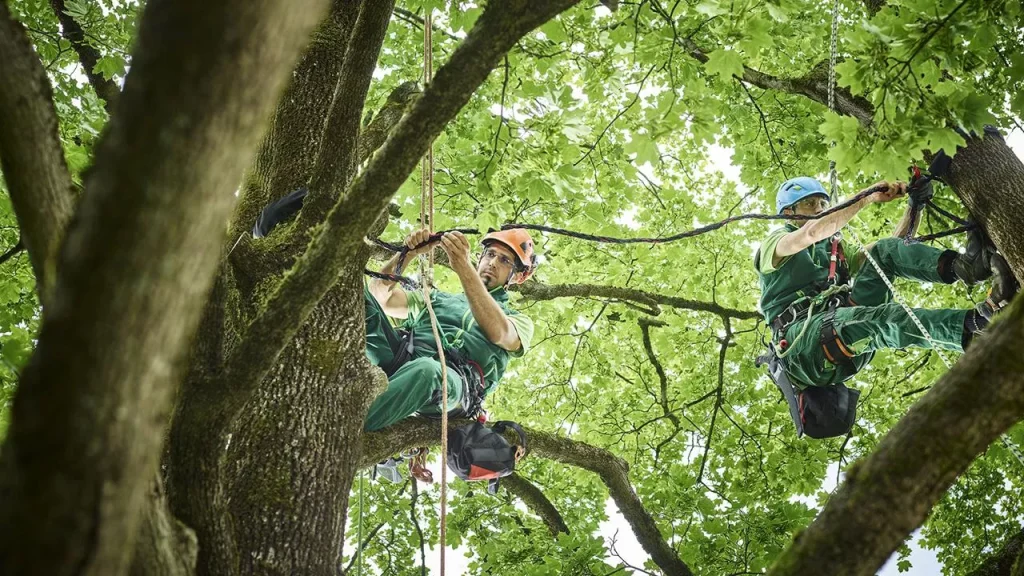Common Tree Issues and How Arborists Address Them
Trees, with their towering majesty and graceful foliage, are an integral part of our natural landscape. However, like any living organism, trees are susceptible to various issues that can compromise their health and vitality. In this article, we will delve into some common tree issues and explore the expert solutions arborists employ to address them, ensuring the well-being and longevity of our arboreal companions.

- Diseases: The Silent Threat Trees, much like humans, can fall prey to diseases. Fungal infections, bacterial diseases, and viral pathogens can affect different parts of a tree, from its leaves and bark to its roots. Arborists play a critical role in identifying the type of disease and implementing effective treatment strategies. Arborists often recommend a combination of cultural practices, such as proper pruning and sanitation, along with targeted fungicides or antibiotics. Regular inspections by trained arborists are essential to catch diseases early, preventing their spread and minimizing the impact on the overall health of the tree.
- Insect Infestations: Unseen Invaders Insects can pose a significant threat to trees, both above and below the ground. Common pests include beetles, aphids, and borers, which can damage leaves, bark, and even the tree’s vascular system. Arborists utilize integrated pest management (IPM) techniques, which may include the release of beneficial insects, the use of insecticidal treatments, or the application of systemic pesticides to protect trees from harmful invaders. Regular monitoring allows arborists to detect pest infestations early, enabling them to implement timely and targeted interventions to save the tree from irreversible damage.
- Structural Issues: The Importance of Stability Over time, trees can develop structural issues, compromising their stability and safety. This can result from factors such as poor pruning practices, storms, or the natural aging process. Arborists assess the structural integrity of trees and may recommend corrective measures such as cabling or bracing to provide support to weak branches or split trunks. Pruning is another key strategy employed by arborists to reduce the risk of structural failure. Proper pruning not only enhances the tree’s overall structure but also removes dead or weakened branches that could pose a danger during storms.
- Soil Compaction and Nutrient Deficiency: Root Concerns Healthy roots are essential for a tree’s well-being, and arborists often encounter issues related to soil compaction and nutrient deficiencies. Compacted soil restricts root growth and limits access to oxygen and essential nutrients. Arborists employ techniques like soil aeration to alleviate compaction, allowing the roots to flourish. Additionally, arborists may recommend fertilization to address nutrient deficiencies. A tailored fertilization plan ensures that trees receive the specific nutrients they need, promoting robust growth and resilience against environmental stressors.
- Environmental Stress: Weathering the Elements Trees are constantly exposed to environmental stressors, including extreme weather conditions, pollution, and changes in soil moisture. Arborists take a holistic approach to mitigate these stressors, incorporating practices such as mulching, which helps regulate soil temperature and moisture levels. In instances of prolonged drought or excessive rainfall, arborists may recommend supplemental watering or drainage improvements to help trees withstand challenging weather patterns. These proactive measures enhance a tree’s ability to adapt and thrive in its environment.
- Root Issues: Unseen Challenges Below Ground Tree roots can face various challenges, from compacted soil to encroachment by construction activities. Arborists employ root collar excavation and other techniques to inspect and address root-related issues. By carefully examining the root zone, arborists can identify and rectify problems that may otherwise go unnoticed, ensuring the tree’s stability and vitality. Root pruning is another common strategy to address issues such as girdling roots, which can constrict the tree’s vascular system. Arborists carefully remove or redirect problematic roots, promoting healthy growth and preventing long-term damage.
Conclusion:
In the hands of skilled arborists, common tree issues become manageable challenges rather than insurmountable threats. Through a combination of proactive care, precise diagnosis, and targeted interventions, arborists play a crucial role in preserving the health and beauty of our arboreal companions. Regular tree inspections, timely treatments, and informed management practices all contribute to a landscape where trees can thrive for generations to come. As stewards of the natural world, arborists stand as guardians, ensuring that our trees continue to enchant and enrich our surroundings.
